
Dighton is a town in Bristol County, Massachusetts, United States. The population was 8,168 at the 2022 census. The town is located on the western shore of the Taunton River in the southeastern part of the state.

Ezra Stiles was an American educator, academic, Congregationalist minister, theologian, and author. He is noted as the seventh president of Yale College (1778–1795) and one of the founders of Brown University. According to religious historian Timothy L. Hall, Stiles' tenure at Yale distinguishes him as "one of the first great American college presidents."
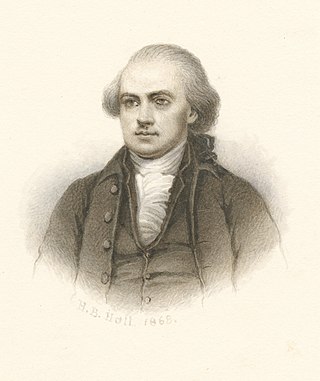
William Ellery was a Founding Father of the United States, one of the 56 signers of the United States Declaration of Independence, and a signer of the Articles of Confederation as a representative of Rhode Island.

Old South Church in Boston, Massachusetts, also known as New Old South Church or Third Church, is a historic United Church of Christ congregation first organized in 1669. Its present building was designed in the Gothic Revival style by Charles Amos Cummings and Willard T. Sears, completed in 1873, and amplified by the architects Allen & Collens between 1935–1937. The church, which was built on newly filled land in the Back Bay section of Boston, is located at 645 Boylston Street on Copley Square. It was designated a National Historic Landmark in 1970 for its architectural significance as one of the finest High Victorian Gothic churches in New England. It is home to one of the oldest religious communities in the United States.
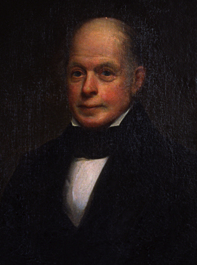
Asher Benjamin was an American architect and author whose work transitioned between Federal architecture and the later Greek Revival architecture. His seven handbooks on design deeply influenced the look of cities and towns throughout New England until the Civil War. Builders also copied his plans in the Midwest and in the South.
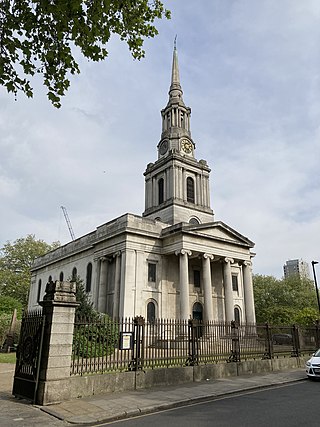
All Saints' Church, Poplar, is a church in Newby Place, Poplar, London Borough of Tower Hamlets, and is the Church of England parish church of Poplar. It was built in 1821–3 to serve the newly created parish.
Morgan Edwards was an American historian of religion, Baptist pastor, notable for his teaching on the "rapture" before its popularization by John Nelson Darby (1800–1882).
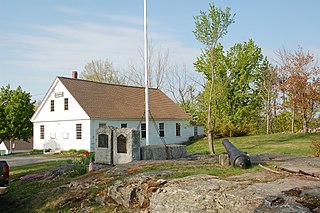
The Lyndeborough Center Historic District, located in the town of Lyndeborough, New Hampshire, United States, consists of three structures: the Town Pound, Town Hall, and Congregational Church. The district was placed on the National Register of Historic Places in 1984. In 2010, by town meeting vote, this district became part of a larger, officially zoned local historic district.

The Clarke Street Meeting House is an historic former meeting house and Reformed Christian church building at 13-17 Clarke Street in Newport, Rhode Island. Built in 1735, the structure is listed on the National Register of Historic Places.

Still River Baptist Church is the home of the Harvard Historical Society. It is an historic Gothic Revival-style meeting house located at 213 Still River Road in Harvard, Massachusetts. The building houses the Harvard Historical Society's museum and archival collections.

The history of Brown University spans 259 years. Founded in 1764 as the College in the English Colony of Rhode Island and Providence Plantations, Brown is the seventh-oldest institution of higher education in the United States and the third-oldest institution of higher education in New England. At its foundation, the university was the first in the U.S. to accept students regardless of their religious affiliation. Brown's medical program is the third-oldest in New England while its engineering program is the oldest in the Ivy League.
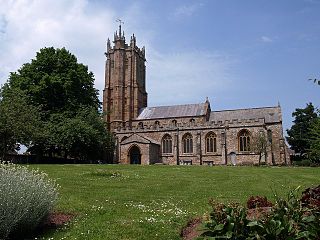
The Church of St John the Baptist in Wellington, Somerset, England, dates from the 15th century and has been designated as a Grade I listed building.

Christian's Church is a Rococo church in the Christianshavn district of Copenhagen, Denmark. Designed by Nicolai Eigtved, it was built 1754–59.

The Brattle Street Church (1698–1876) was a Congregational and Unitarian church on Brattle Street in Boston, Massachusetts.

South Congregational Church is a historic church building at 58 S. Main Street in Newport, New Hampshire. The two-story brick church was built in 1823 by the carpenter John Leach for a congregation established in 1779, and is the most northerly of a series of rural churches based on a design used by Elias Carter in the design of the Congregational church in Templeton, Massachusetts. The church building was listed on the National Register of Historic Places in 1989. The congregation is affiliated with the United Church of Christ.
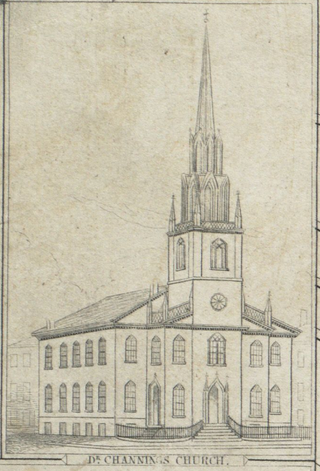
The Federal Street Church was a congregational Unitarian church in Boston, Massachusetts. Organized in 1727, the originally Presbyterian congregation changed in 1786 to "Congregationalism", then adopted the liberal theology of its fifth Senior Minister, William Ellery Channing, (1780–1842). For most of the 18th century the church was known as the Long Lane Meeting-House. In 1788, state leaders met in the relatively spacious building to determine Massachusetts' ratification of the United States Constitution. Thereafter the church renamed itself the Federal Street Church in honor of the event. In 1803, it called William Ellery Channing, (1780–1842), as its minister who defined "Unitarian Christianity" and launched the Unitarian movement, making the Federal Street Church one of the first to define itself as Unitarian.

First Unitarian Church of Providence is an American Unitarian Universalist congregation located at the corner of Benefit and Benevolent Streets in Providence, Rhode Island. The congregation was founded in 1723, and the current church building was dedicated in 1816. For many years it was known as the First Congregational Church of Providence.
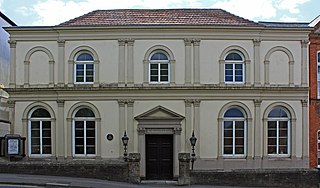
Taunton Unitarian Chapel is on Mary Street, Taunton, Somerset, England. It was built in the early 18th century as a Baptist chapel, but later adopted Unitarianism. The exterior was extensively renovated in the 19th century in an Italianate style. The chapel has been designated as a Grade II* listed building.

The Protestant Reformed Dutch Church of Flushing is a historic house of worship located at Roosevelt Avenue and Bowne Street near the center of Flushing, Queens, New York City. Built in the Romanesque Revival style, it is notable for a tall corner bell tower, extensive use of decorative brickwork, and its opalescent glass windows. The denomination has roots in the founding of New Netherland, and many other Reformed congregations were established during the 19th century in the former Dutch settlements along the Hudson River.






















